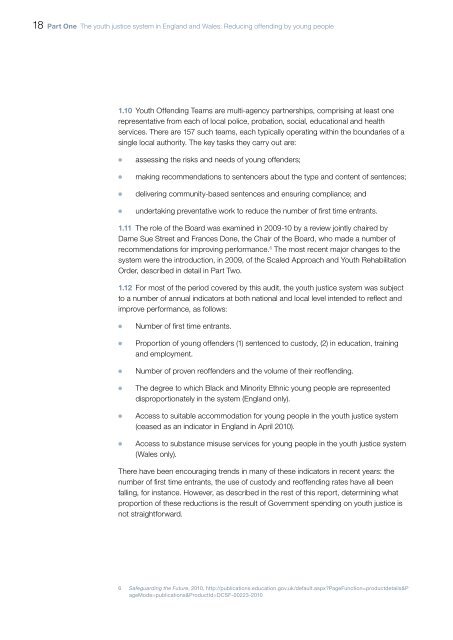full report - National Audit Office
full report - National Audit Office
full report - National Audit Office
Create successful ePaper yourself
Turn your PDF publications into a flip-book with our unique Google optimized e-Paper software.
18 Part One The youth justice system in England and Wales: Reducing offending by young people<br />
1.10 Youth Offending Teams are multi-agency partnerships, comprising at least one<br />
representative from each of local police, probation, social, educational and health<br />
services. There are 157 such teams, each typically operating within the boundaries of a<br />
single local authority. The key tasks they carry out are:<br />
¬¬<br />
¬¬<br />
¬¬<br />
¬¬<br />
assessing the risks and needs of young offenders;<br />
making recommendations to sentencers about the type and content of sentences;<br />
delivering community-based sentences and ensuring compliance; and<br />
undertaking preventative work to reduce the number of first time entrants.<br />
1.11 The role of the Board was examined in 2009‐10 by a review jointly chaired by<br />
Dame Sue Street and Frances Done, the Chair of the Board, who made a number of<br />
recommendations for improving performance. 6 The most recent major changes to the<br />
system were the introduction, in 2009, of the Scaled Approach and Youth Rehabilitation<br />
Order, described in detail in Part Two.<br />
1.12 For most of the period covered by this audit, the youth justice system was subject<br />
to a number of annual indicators at both national and local level intended to reflect and<br />
improve performance, as follows:<br />
¬¬<br />
¬¬<br />
¬¬<br />
¬¬<br />
¬¬<br />
¬¬<br />
Number of first time entrants.<br />
Proportion of young offenders (1) sentenced to custody, (2) in education, training<br />
and employment.<br />
Number of proven reoffenders and the volume of their reoffending.<br />
The degree to which Black and Minority Ethnic young people are represented<br />
disproportionately in the system (England only).<br />
Access to suitable accommodation for young people in the youth justice system<br />
(ceased as an indicator in England in April 2010).<br />
Access to substance misuse services for young people in the youth justice system<br />
(Wales only).<br />
There have been encouraging trends in many of these indicators in recent years: the<br />
number of first time entrants, the use of custody and reoffending rates have all been<br />
falling, for instance. However, as described in the rest of this <strong>report</strong>, determining what<br />
proportion of these reductions is the result of Government spending on youth justice is<br />
not straightforward.<br />
6 Safeguarding the Future, 2010, http://publications.education.gov.uk/default.aspx?PageFunction=productdetails&P<br />
ageMode=publications&ProductId=DCSF-00223-2010

















